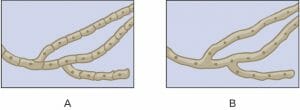Hyphae (singular, hypha) are long, filamentous, tube-like structures which are the basic building blocks of fungi. They cluster together to form mycelium which make up the thallus or fruiting body of the fungus. Inside hyphae are cytoplasm, nuclei, and various organelles. The main functions of hyphae are absorbing nutrients from the environment and providing a transportation network throughout the fungus. Yeast is an exception because it is one type of fungus that does not have hyphae. However, they form incomplete buds called pseudohyphae.
Septate Hyphae
Some fungi have hyphae divided into cellular compartments by walls called septa. Septa have tiny perforations which allow molecules, cytoplasm, and sometimes organelles to move between the cells. Fungi can close their septa if they are injured, preventing fluid loss from the rest of the filament.
There are many species of fungi with septate hyphae including those in the genus Aspergillus and the classes Basidiomycetes and Ascomycetes. When Basidiomycetes mate with each other, the septa of one of the parents degrades to allow the incoming nuclei from the other parent to pass through the hyphae. After the nuclei have established themselves, the septa are reformed.
In some species of fungi that have wide hyphae, the septa act as support structures in addition to being barriers. When hyphae grow at their tips, the septum does not form right away. As the cell matures, the wall grows out into the cytoplasm, eventually spanning the width of the hyphae.
Non-Septate Hyphae
These types of hyphae are also called aseptate or coenocytic. They represent a more primitive form of fungi and are the ancient ancestors of septate hyphae. Fungi of the genus Mucor and the division Zygomycetes are non-septate. Non-septate hyphae do have some septa, but they are found only at the branching points. If there were no septa at all, the entire fungus would be at risk of compromise if even one hypha were damaged.
Non-septate hyphae are the result of the nucleus repeatedly dividing but not the cytoplasm. This can result in many nuclei in the cytoplasm along with other organelles such as ribosomes, endoplasmic reticulum, and Golgi apparatus.

The drawings above illustrate hyphae with septa (A) and without (B).
References
- Ahmadjian, V., Alexcopoulos, C.J. & Moore, D. (2018). Fungus. In Encyclopedia Britannica online. Retrieved from https://www.britannica.com/science/fungus
- Hypha. (n.d.). In Wikipedia. Retrieved April 23, 2018 from https://en.wikipedia.org/wiki/Hypha
